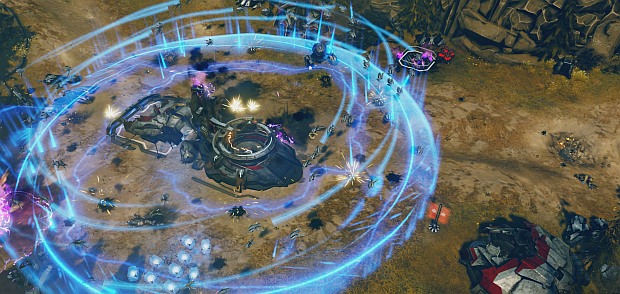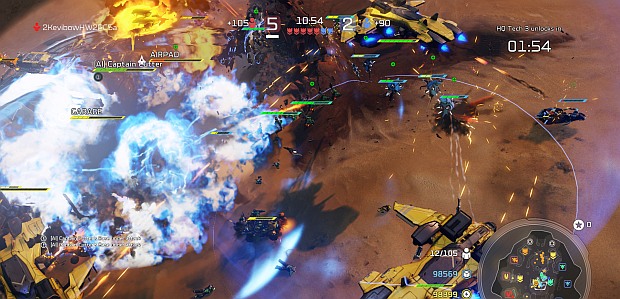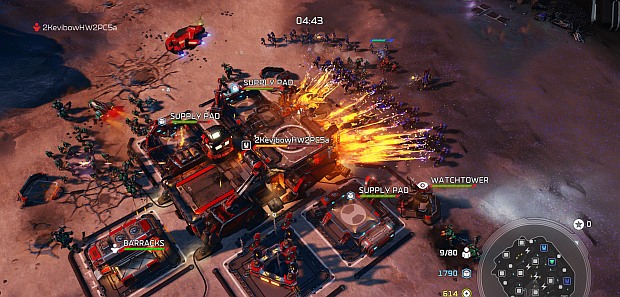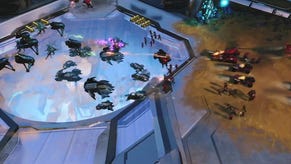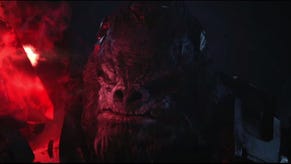Halo Wars 2's Blitz Mode could be its salvation
Creative Assembly's other other RTS
I was all set to thoroughly dismiss Halo Wars 2 [official site], before I joined Microsoft for a spot of top-down Warthog-baiting earlier in the month, and I'm still not completely convinced. Last year's Xbox One beta suggested yet another Halo game intent on rebottling the lightning of a departed era - in this case, that fleeting, Quixotic period when the idea of RTS on console sounded like cash in the bank.
Much of what made the original Halo Wars work so well on Xbox 360 has been preserved - the snappy, colourful visual design, the stripped-down resource and research aspects, the adroit translation of Halo's alien Covenant and human UNSC factions into the language of an Age of Empires spin-off. Startlingly little has been added or changed, whether you're talking about new units or a fresh approach to the typically leaden business of storytelling in a strategy game. This is exactly what many fans are hoping for, I'm sure, but given Creative Assembly's success with the Warhammer license and Alien: Isolation, it's hard not to wish for a shade more, well, magic.
Fortunately, Creative Assembly has at least one ace in the hole - Blitz Mode, which is available in beta from 20th January, and is essentially Halo Wars with a punchy, team-based card game in place of the base and army-building you'll find in the campaign and traditional multiplayer. In Blitz, players pick a general, which mostly determines the units you'll start a match with, and a customisable deck of 12 cards, unlocked through play or purchased - as will ultimately be the fate of all things - from the Xbox Marketplace. Each card is either a leader power (think healing auras, missile strikes and holographic decoys) or a unit, from entry-level UNSC Marines to exotic variations like Marauder tanks armed with cloaking devices and everybody's favourite surprise party guest, the kamikaze Grunt.
Once in the field, cards are doled out randomly in hands of four, and played by spending energy points (you can also sacrifice a bit of energy to draw a replacement card). In standard competitive Blitz, each player earns energy passively at a sluggish rate, but you can speed things up by farming crates that are dropped at preset locations around the map at regular intervals. The twist is that Blitz is all about taking territory – three capture zones, on the Proving Grounds map that I played. Bagging one of these zones at the outset is straightforward enough, but every second you spend holding the fort is a second your opponents will likely spend scouring the map for energy. You can dispatch individual units to forage, but given that drop locations are foreknown, it's easy for an enemy to choke off supply.
The consequence is a game of pure micro and 1000 mph reversals that can be either a carefree distraction or a serious test of reflexes and tenacity, depending on the commitment and expertise you bring to bear – an experience in which army compositions shift moment to moment, as defenders are nuked and reinforcements conjured from the ether. At one point I was muddling along with a gaggle of jump-jetting Brutes, ponderous Wraith tanks and fast-moving Choppers, only for half of them to be wiped out from off-screen by entrenched Kodiak artillery. Frenzied, I hurled fistfuls of cards at the battlefield and somehow ended up with a platoon of scurrying Locust death-ray machines, who promptly deep-fried the Kodiaks like so much brie. All this in the space of around 10 seconds.
There are plenty of precedents in other strategy titles, not least MOBAs, but the effect on Halo Wars is electric, all the same – tech trees and economy-building are a distant memory, and the intricacies of each unit's design are thrust to the fore. There's also a PvE variant, Firefight, which disables passive energy replenishment and sees you toughing it out against ever-larger waves of increasingly high-calibre AI troops, spawned from one corner of the map. An obvious team strategy here is to take turns corralling the AI, one player shutting down the invasion at source while the others farm the map, but there will come a point when the assault requires everybody's attention.
Energised by Blitz, I found myself more willing to appreciate the finer points of Creative Assembly's reworking of Ensemble's template. The feel in campaign and traditional multiplayer is much as in 2009 (and not worlds away from the original Age of Empire, released in 1997). Bases are built in preset locations, and consist of a hub surrounded by plots for resource buildings and unit factories. Higher grades of unit like the UNSC's sturdy Scorpion tanks or the Covenant's unsightly yet devastating Blisterback missile platforms are unlocked by upgrading the hub.
Each type of factory also offers a welter of unit upgrades – grenades for Marines, for example, or turrets for your Warthogs – which can be more decisive at times than brand new units. There are no dedicated resource-gathering units, but you can send infantry to harvest the supply caches and Forerunner power generators that dot most maps. Control of the latter can be crucial, but it's obviously unwise to weave a strategy around energy supplies that lie far beyond your defences.
CA has tweaked the game's economic and construction underbelly a little, somewhat to fan ire. The addition of a second resource type may strike some players as a welcome pressure, others as needless fuss. The fact that there's no longer a dedicated research building also makes it harder to sabotage an opponent's access to elite units, including monstrous entities like the Covenant Scarab – rather than drive-by-shooting reactors, you'll have to target either the construction facility in question or blow up the entire base.
Less controversially, the new mouse-and-keyboard interface covers all the options you'd want in a game of this ilk, from numbered control groups through unit order queueing to the ability to save and tab to map locations. The presentation is also surprisingly sensitive, as chaotic as things can get – units are distinguished by neat little animations, such as Covenant turrets shifting back and forth on their supports like nervous crabs, and unit barks do a good job of filling you in on events out of view. I was frequently able to distinguish who exactly was being clobbered by what from the audio alone.
The campaign missions are the game's least intriguing features so far – an extended tutorial comprised of linear scraps against semi-scripted opposing forces. It doesn't help that Halo's over-arching story and universe are so long in the tooth – I used to edit Halo bookazines for a living and let me tell you, one ancient Forerunner artefact is pretty much another, however huskily it's introduced. There are only so many wistful choral interludes a man can take before he resorts to the bottle. With any luck, later missions will owe more to the original game's more inspired chapters than the burgeoning swamp of melodrama that is the expanded Halo universe. That scrap with the half-destroyed Scarab, for example, or the fight against the Flood on the hull of a UNSC cruiser.
Halo Wars 2 is unlikely to be a transcendent hit, but there are touches of greatness throughout its design, and if this is Creative Assembly at its least imaginative, the execution seems watertight. It has a great foundation to build on and in the form of Blitz, at least, a hint of sorely needed swagger. Let's hope it finds its feet.


